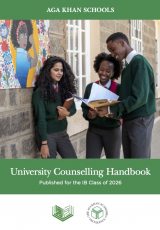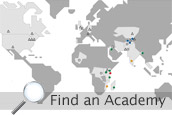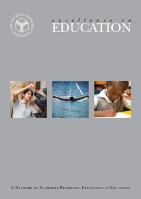Technology & education: A gateway to the future
Today’s classroom is one that is worlds away from that of previous generations. The influx of laptops, smartphones and tablets, combined with students who are both digitally and technologically literate, have transformed the educational landscape. Faced with this transformation, educators, along with existing educational systems and infrastructure, will need to evolve, taking the best of what new technology has to offer and moulding it to enhance the learning experience.
The Aga Khan Academies are fertile ground for the growth and development of this technological evolution. In facilitating access to and aiding the development of technological innovation in the classroom, the Academies are adapting to the changing educational landscape. The first step in this process has been the establishment of a secure, reliable and easily accessible Internet infrastructure.
Sanjeeb Mohanty, group head of information and communications technology at the Aga Khan Academies, explains, “We have created a network that is intelligent enough to understand what each student is trying to do within their own sphere.” The new network is secure enough to sustain a variety of external threats and possesses the necessary bandwidth to accommodate students who are coming to school with one or more Internet-capable devices. In allowing staff and students the access and ability to connect to a wider variety of online content, the Academies have widened the scope for online educational engagement. “The Academies have set up a state-of-the-art network with a modern concept; in a technological sense [this] is called BYOD (Bring Your Own Device),” explains Sanjeeb. Providing such a network on the 100-acre Hyderabad campus was no easy task, but students can now, at anytime and from anywhere, safely and securely connect to the Internet.
For the Academies, a genuine technological evolution involves more than increasing connectivity and accessibility. It involves the use of technology to reshape pedagogy, with the aim of furthering a student’s development both in and outside the classroom. Karim Ismail, curriculum coordinator for the Aga Khan Academies, explains that as part of a pilot programme, students at the Academy in Hyderabad were given iPads and encouraged to use them while completing schoolwork. Using the devices in their mathematics classes, students were able to clearly undertake challenging problems, whilst digitally sharing their work with both instructors and peers. “You have accomplished students wanting to demonstrate what they have been learning, [and being] able to do so with the flick of their stylus,” says Karim. The use of iPads is only one aspect of the Academies’ partnership with Apple. Through the Apple Professional Development programme, Apple will provide specially trained educators to help Academy faculty and staff better incorporate technology into their curriculum, enhancing both the teaching and learning experience.
At another level, video conferencing and Skype access carry the exciting prospect of bringing pluralism to life. In speaking about the possibilities, Karim passionately explains, “A critical part of what we are doing [at the Academies] is exposing students to pluralism, and what better way to do that than to introduce a student who will be in Dhaka to a student from Dar es Salaam and say, ‘Guess what, you are both 13 years old, you are both learning through the same knowledge material, you are both part of the same schools, but what are your differences? How are those differences strengths? What can we do to learn about our strengths from each other?’ That is such a powerful way to explore pluralism before even leaving the confines of the classroom.” In a few trial sessions, this technology has enabled students from Hyderabad to connect with those from Mombasa. These interactions not only expose students to their counterparts from other backgrounds and cultures but also prepare them for the globalised world environment.
The use of technology in the classroom has also equipped students with the real-world skills they will require when they graduate. Allowing for the presence of the Internet and Internet-capable devices raises learning opportunities on appropriate use of social media and the Internet as a whole. Noting that it would be impossible to eliminate access to these sites, Karim elaborates, “The reality is the students will access the Internet, either within our Academy or outside. So, what if we educate them on the appropriate way to present yourself online, the appropriate way to behave online? That in itself is an education that is on par in its value to the student as the times table that they are learning in the classroom. That is critical knowledge they need to survive in the outside world.”
It is not only the students who have been able to reap the benefits of the Academies’ technological advances. The use of ManageBac, an online system designed specifically for the management of the International Baccalaureate curricula, has helped faculty across the network of Academies to organise and successfully implement their curricula. A common and easily accessible platform, ManageBac allows faculty to monitor their students’ progress, while allowing for collaboration and exchange among faculty members in the spirit of continued professional development. The use of a new automated library management system will also aid both students and faculty. The system, named Mandarin Oasis and soon to be implemented in the Mombasa and Hyderabad campuses, will enable students and faculty to easily access library resources online. The platform will allow students to track online the status of books, while streamlining the issuing and return of library materials.
For the Academies, reaching this point has not been without its challenges. Sanjeeb explains that the lack of infrastructure and high cost of materials have all been major difficulties. The developing world is a challenging environment in which to pioneer technological and educational innovation, and the geographic spread of the Academy network has made the task especially difficult. “I think the locations of the Academies is a major and a massive challenge,” he notes. “What I am able to do in Hyderabad instantly, or in a couple of days, I am not able to do in Mombasa.” Yet as the world develops, and areas like sub-Saharan Africa continue to experience economic growth, Sanjeeb holds no doubt of what the future holds. “We are making progress, but it will take time.”
The progress being made is marked by efficiency as well as social responsibility. Sanjeeb explains that in both Hyderabad and Mombasa, traditional desktop computers are being replaced with virtualised systems that both enhance the user experience and address data security issues. These new systems are highly efficient, run at a decreased cost and require less maintenance.
Looking towards the future, the opportunities for expansion and development of technology in the field of education are endless. Possible areas of further exploration include the ways in which technology can be harnessed to alter existing pedagogical methods. One of these is the flipped classroom model, which is being used with senior students at the Academy. Karim explains that in the flipped classroom model, the student “is given the opportunity to engage with the instructional elements of learning outside of the classroom, often through engaging with a recorded tutorial or other media before the class, at a pace that suits that individual child’s learning needs. The time with the teacher then, becomes far more focused on the individual’s learning. The student can use the lesson to explore and problem-solve under the guidance of their teacher, and the teacher is in a powerful position to effectively evaluate the extent of the child’s learning, intervening when appropriate.” This model, used in world-class universities, is hugely powerful as it allows for students to work at their own pace and comfort level, promoting a more comprehensive understanding of the subject material. These methods hold great promise, Karim remarks, adding, “We have got to look for ways in which the Academies will get at the cutting edge of education by using these kinds of pedagogical tools.”
While technology has irrevocably refashioned the educational landscape, one cannot forget that, at the end of the day, technology serves a specific purpose. Karim reminds us that technology “is a support, it is a resource, it is not the object of study. Rather [it is] a means by which education becomes more exhaustive in the knowledge that is explored, more relevant in the examples that are referenced, and more engaging to a child who has been born in a digital world. And as a part of this education, it is a duty to help learners determine when it is fitting to engage with technologies, and when learning accelerates in its absence.”
In his remarks made at the North-South Prize ceremony in Lisbon Portugal, His Highness the Aga Khan noted, “The lesson it seems to me is that technologies alone will not save us – the critical variable will always be and will always lie in the disposition of human hearts and minds.” When all is said and done, it is this human disposition which the Academies seek to cultivate for the betterment of both individual and society.
By Farhan Karim
Newsletter readers please click here to return to the newsletter (browser version)
publications




